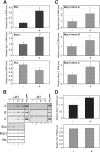Estrogen down-regulation of the Scx gene is mediated by the opposing strand-overlapping gene Bop1
- PMID: 19996321
- PMCID: PMC2836086
- DOI: 10.1074/jbc.M109.036681
Estrogen down-regulation of the Scx gene is mediated by the opposing strand-overlapping gene Bop1
Abstract
Recent genome-wide transcriptome studies suggest the presence of numerous bidirectional overlapping coding gene pairs in mammalian genomes. Various antisense RNAs are reported as non-coding RNAs that regulate the expression of sense RNA. However, it is still unclear whether the expression of bidirectional overlapping coding genes are regulated by the opposite strand gene transcript acting as a non-coding RNA. Bop1 and Scx are a pair of bidirectional overlapping coding genes related to cellular proliferation and differentiation, respectively. Scx gene is localized in the intron 3 region of the Bop1 gene. The expression of these genes is reciprocally regulated by estrogen (E2) in the mouse uterus. In situ hybridization indicated that both genes are expressed in the uterine endometrial epithelial cells and that the antisense RNA of Scx (Bop1 intronic RNA) accumulates as a stable RNA in these cells. The existence of Bop1 intronic RNA was confirmed by reverse transcription-PCR and was increased after E2 treatment, coinciding with a decrease in Scx mRNA. Murine myoblasts expressing doxycycline-inducible endogenous Bop1 gene showed an increase in Bop1 intronic RNA and a simultaneous decrease in Scx mRNA. Murine fibroblasts expressing Scx mRNA from an exogenous Scx mini-gene indicated that the accumulation of Bop1 intronic RNA impairs the Scx gene expression in a trans-acting manner, which resulted in the reduction of the Scx mRNA level. This study demonstrates a novel example of hormone-stimulated intronic non-coding RNA down-regulating the expression of an opposing strand-overlapping coding gene.
Figures





Similar articles
-
Differential spatiotemporal regulation of lactoferrin and progesterone receptor genes in the mouse uterus by primary estrogen, catechol estrogen, and xenoestrogen.Endocrinology. 1998 Jun;139(6):2905-15. doi: 10.1210/endo.139.6.6051. Endocrinology. 1998. PMID: 9607801 Free PMC article.
-
Differential regulation of heparin-binding epidermal growth factor-like growth factor in the adult ovariectomized mouse uterus by progesterone and estrogen.Endocrinology. 1994 Sep;135(3):1264-71. doi: 10.1210/endo.135.3.8070372. Endocrinology. 1994. PMID: 8070372
-
Estrogen regulates the synthesis of epidermal growth factor in mouse uterine epithelial cells.Mol Endocrinol. 1990 Mar;4(3):510-23. doi: 10.1210/mend-4-3-510. Mol Endocrinol. 1990. PMID: 2342484
-
[Non-coding Natural Antisense RNA: Mechanisms of Action in the Regulation of Target Gene Expression and Its Clinical Implications].Yakugaku Zasshi. 2020;140(5):687-700. doi: 10.1248/yakushi.20-00002. Yakugaku Zasshi. 2020. PMID: 32378673 Review. Japanese.
-
The Antisense Transcriptome and the Human Brain.J Mol Neurosci. 2016 Jan;58(1):1-15. doi: 10.1007/s12031-015-0694-3. Epub 2015 Dec 23. J Mol Neurosci. 2016. PMID: 26697858 Review.
Cited by
-
Induced pluripotent stem cell-derived tenocyte-like cells promote the regeneration of injured tendons in mice.Sci Rep. 2020 Mar 4;10(1):3992. doi: 10.1038/s41598-020-61063-6. Sci Rep. 2020. PMID: 32132649 Free PMC article.
-
Epigenetic control of embryo-uterine crosstalk at peri-implantation.Cell Mol Life Sci. 2019 Dec;76(24):4813-4828. doi: 10.1007/s00018-019-03245-8. Epub 2019 Jul 27. Cell Mol Life Sci. 2019. PMID: 31352535 Free PMC article. Review.
-
Scleraxis is required for maturation of tissue domains for proper integration of the musculoskeletal system.Sci Rep. 2017 Mar 22;7:45010. doi: 10.1038/srep45010. Sci Rep. 2017. PMID: 28327634 Free PMC article.
References
-
- Katayama S, Tomaru Y., Kasukawa T., Waki K., Nakanishi M., Nakamura M., Nishida H., Yap C. C., Suzuki M., Kawai J., Suzuki H., Carninci P., Hayashizaki Y., Wells C., Frith M., Ravasi T., Pang K. C., Hallinan J., Mattick J., Hume D. A., Lipovich L., Batalov S., Engström P. G., Mizuno Y., Faghihi M. A., Sandelin A., Chalk A. M., Mottagui-Tabar S., Liang Z., Lenhard B., Wahlestedt C. (2005) Science 309, 1564–1566 - PubMed
-
- Numata K., Okada Y., Saito R., Kiyosawa H., Kanai A., Tomita M. (2007) Gene 392, 134–141 - PubMed
Publication types
MeSH terms
Substances
Grants and funding
LinkOut - more resources
Full Text Sources
Molecular Biology Databases

